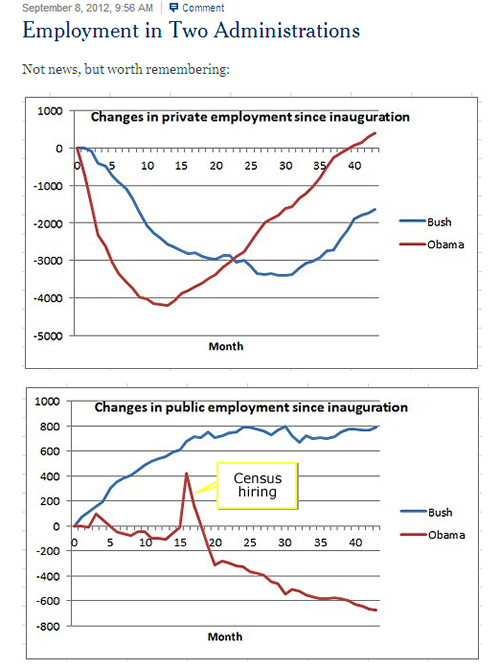Watching the Economy by Clint Burdett CMC® FIMC
September 2012
The Jobs Conundrum
Krugman charts (below from his NYT Blog The Conscience of a Liberal 9/8/2012) represents net job creation to date. As ever, there is a political message in his presentation - Republican v Democrat administrations impact on jobs.
When will net jobs increase (recover from the Great Recession) from private employment growth and government sector job loss? Note the month count on the x axis.
Reinhart and Rogoff's research suggests employment takes on average 4.8 years (58 months) to return to the employment at crisis onset. The Obama's inauguration lags the Great Recession onset by 14 months.
Eyeballing Krugman's charts at 43 months: 700,000 more private jobs - 750,000 fewer government jobs and Obama back where he started but the mix is more private sector, fewer government jobs.

The next chart represents the severity of the Great Recession job losses, the starting point the onset of eleven post WWII recessions.
Looking at the percentage job loses (from the peak employment month before the onset of a recession) Bill McBride's (Calculated Risk) chart shows there are many jobs left to create. (The slope is lower for the 2007 and 2001 recessions, both Administrations taking longer to return to the onset employment.)
If "normal" unemployment is just above 5% of the population, then we still need to reduce unemployment about 3.5%.

We are following the job creation pattern for a severe banking crisis (also called deleveraging or financial crises) but with population growth, we are still behind to spur demand. Obama Administration impact on job recovery compared to other financial crisis - above average for his 43 months.
Where would we normally see jobs created? Demand from the housing sector is just taking off (http://goo.gl/p2VdA), usually the pace of the recovery and this time slow, late in the cycle. So be patient.
But, an European (now) or USA fiscal cliff (start of 2013) trigger for a USA recession in the offing.
What comes first: demand for products and services (more new homes and DYI remodels) or more jobs to increase the number of buyers? The conundrum is one party wants to continue to cuts government (mostly local or state activities that fund jobs), the other party wants to stay the course (we are done cutting - be patient). Given American electoral politics, neither approach will spur demand in the short term.
Can government spur demand or at least, do no harm now? I don't expect after US election from the lame duck Congress, an elegant, consensus approach to avoid the Fiscal Cliff. Business leaders holding off now on new private hires anticipating more do nothing congressional politics.
Job growth slowing. Demand for goods and services to drop with the uncertainty. A double whammy.
Check your foot for that bullet hole in February.
You may not reprint this article for sale without my expressed written permission.
You may post or reprint this article to educate as long as you credit my work
and provide a link to www.clintburdett.com
|
|